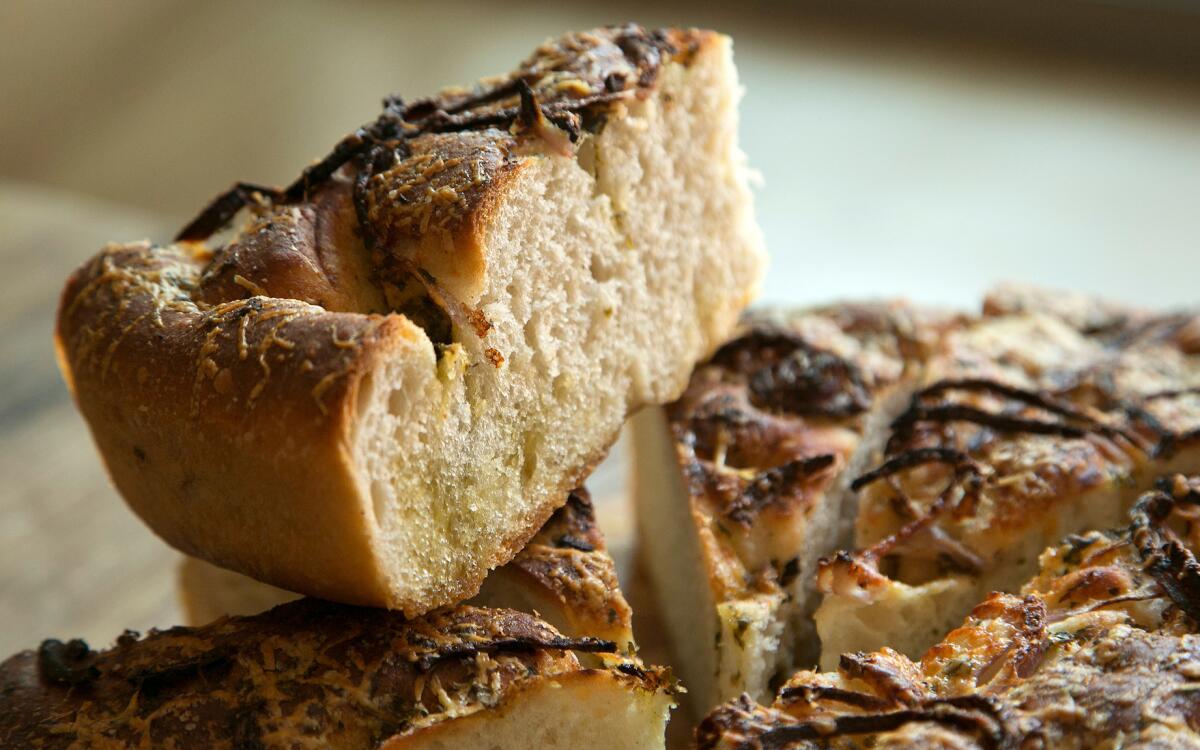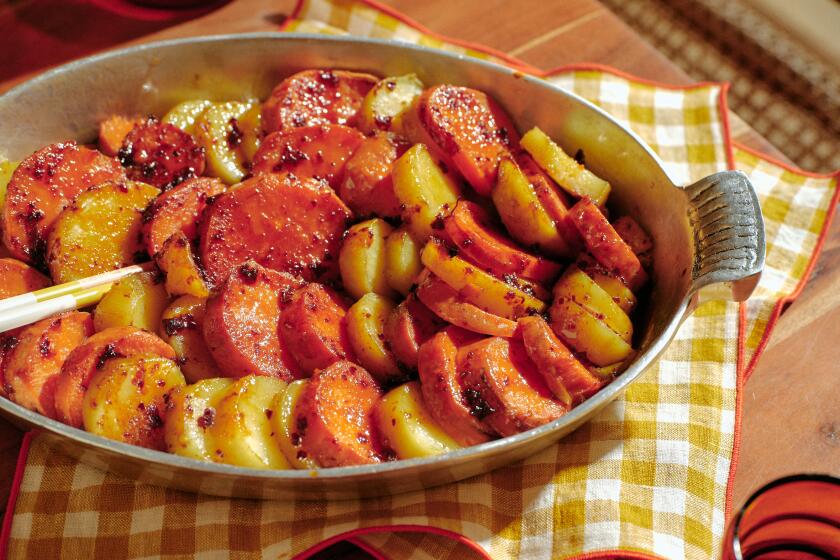Focaccia

“If I wasn’t in the kitchen, I’d probably be a mechanic,” says Duff Goldman. The owner of Charm City Cakes and longtime Food Network star is known for his imaginative and at times gravity-defying cake creations. “I love messing with things and figuring them out.”
Goldman is busy in his home kitchen, baking. His apartment is like a bachelor’s dream pad — a little light on furniture, decorated with guitars on stands, a motorcycle helmet or two in the corner, and custom skateboard decks hanging on the wall. The small kitchen is outfitted with metro shelves full of baking and cooking equipment, and he’s just installed a massive aquarium next to the granite countertop. “I can’t wait to start adding fish,” he says. “It’s going to be awesome.”
But today there’s not a cake in sight – Goldman is baking bread. Focaccia, to be exact. “I’ve always loved baking bread,” he says, kneading the dough. “There’s the science to it, and the beauty.”
Goldman, 41, was baking bread before he ever got into cakes. While studying at the Culinary Institute of America campus in Napa Valley, he got a job at a local bakery. “It was amazing. I worked with these two guys who were the best bread bakers. They taught me so much. We’d turn out 1,000 baguettes and 2,000 rolls a day.”Goldman would show up at the bakery just as the two bakers were finishing mixing and shaping the breads to proof. “They had the hard part. I just baked.” Goldman would bake through the night, working with a massive old oven that creaked as it rotated. “It was Zen-like. I was there all night by myself. But here was this visceral satisfaction at the end of each shift, just looking at all the bread on the racks.”
Goldman started making focaccia around 1995, when he got a job at Savannah Restaurant in Baltimore under chef Cindy Wolf. “My job was baking cornbread and biscuits, but she let me play around with recipes in my spare time.” He credits Wolf with really allowing him to experiment with his own recipes.
Later, Goldman was the bread baker for chef Todd English at Olives in Washington, D.C. “His focaccia is awesome.”
Goldman started Charm City Cakes in Baltimore in 2000. “I was baking cakes out of my apartment while I was in a band to support myself. I’d bake cakes for a while, then take time off to go on tour” with the band. Not long after, Goldman’s creations began to get noticed, and the rest is Food Network history. Still, his passions haven’t strayed from the bread baking of his earlier years.
“If I could stop doing cakes and bake bread and still have the lifestyle I have, I would.”
In the kitchen, Goldman is Snapchatting a quick video of the focaccia as it proofs in the pans. “There’s a lot of focaccia in the world and most of it is terrible. People need to learn about the good stuff.”
Bread may be more of a personal hobby for Goldman now, though he devotes chapters to bread and other baked goods, including pies and pastries, as well as gluten-free and vegan recipes, in his book “Duff Bakes: Think and Bake Like a Pro at Home,” co-written with Sara Gonzalez.
To give his focaccia added flavor, Goldman starts with a biga, or starter dough. Nothing more than a combination of flour, yeast, water and a touch of sugar, the biga is a soft, wet dough Goldman refrigerates for a while before using. “Give it about three days to ferment. This gives the bread more depth of flavor and helps to make those big holes.”
To the biga, he adds more flour – an equal mix of all-purpose and bread flours – and yeast, along with a little oil and salt, mixing everything to combine a soft, smooth dough. “It’s important not to mix too fast. You’re developing the structure.”
When the dough is risen, Goldman prepares the pans with a good coating of oil. “The bread is basically going to deep-fry on the bottom. This is what gives it that amazing crust, almost like fry bread.” He divides the dough, stretching and shaping the rounds in the pans.
When it comes to toppings, Goldman likes to coat his dough in a vibrant green basil oil he flavors with Parmesan cheese, covering the entire top of the dough before he docks the focaccia with his fingertips.
“Then you gotta make the claw with your hands and Bruce Lee the basil oil in the dough so you get these beautiful green streaks in the bread. It’s soooooooo good!” A little sliced onion and more Parmesan, and the focaccia is good to go.
No other toppings? “You could put anything on it. Meat. Pork products. I think tomatoes are kind of stupid,” says Goldman, “but yours is yours and mine is mine. Make it to suit yourself.”
“No matter how many times you bake bread, you’re always still stoked. It’s amazing. It’s magical.”
Biga
In a large, deep bowl or deep container (large enough to allow the dough to double or triple in size), whisk together the water, sugar and yeast. Whisk in the flour to form the biga, or starter dough; this will be a thin, sticky dough similar to wet cement. Cover the container and refrigerate for 3 days.
Basil oil
The day you plan to finish the focaccia, make the basil oil. In a blender, combine the basil, cheese and oil, and purée. Cover and refrigerate until ready to use.
In the bowl of a stand mixer, combine the yeast, sugar and water. Set aside until the yeast begins to bubble, or bloom, about 10 minutes.
Beat in the biga, then begin adding the all-purpose and bread flours, beating until incorporated to form a dough. Before adding the last cup of each flour, beat in the oil and salt. Add the rest of the flour, mixing until the dough is smooth and somewhat sticky. Remove the dough to a well-floured board and gently knead until the dough feels soft and smooth.
Place the dough in a greased bowl, cover and set aside in a warm place until the dough is risen and almost doubled in size, about 1 hour.
Heat the oven to 425 degrees.
Coat each of two (12-inch by 2-inch) cake pans generously with about 4 tablespoons olive oil and sprinkle the bottom of each pan with a light coating of cornmeal.
Divide the dough in half and form each half into a round. Place each round in a pan, gently stretching the dough to fit the diameter of the pan. If it springs back, give the dough a few minutes to relax, then stretch again.
Generously coat the top of each focaccia with a layer of basil oil, making sure the entire top is covered. Making a claw shape with your hands, press your fingertips into the dough, forming deep dimples in the dough and allowing the basil oil to penetrate into the holes. Set the focaccia dough aside until puffed and almost doubled in height, 20 to 40 minutes (rising timing will vary depending on the temperature of the room).
Coat the onion slices with the remaining basil oil (this will keep them from burning as they bake). Shake off the excess oil and sprinkle half of the slices over the risen dough, then sprinkle over ½ of the Parmesan cheese over the dough. Repeat with the second pan of dough.
Place one pan in the oven and bake until the focaccia is crisp and a rich golden-brown, and the cheese is toasted and onions are dark and crisp, 25 to 35 minutes. Check the focaccia occasionally as it bakes, checking to make sure it does not rise up over the sides of the pan and that no oil spills over. Rotate the bread about halfway through baking for even coloring.
Remove the pan to cool slightly on a wire rack, and bake the second focaccia. When cool enough to handle, remove the focaccia from the pan. The bread is best eaten within 12 hours. Store at room temperature. Warm, as desired, on a baking sheet in a warm oven.
Get our Cooking newsletter.
Your roundup of inspiring recipes and kitchen tricks.
You may occasionally receive promotional content from the Los Angeles Times.
















